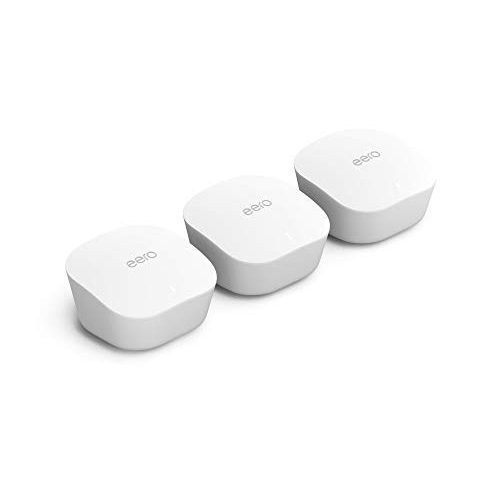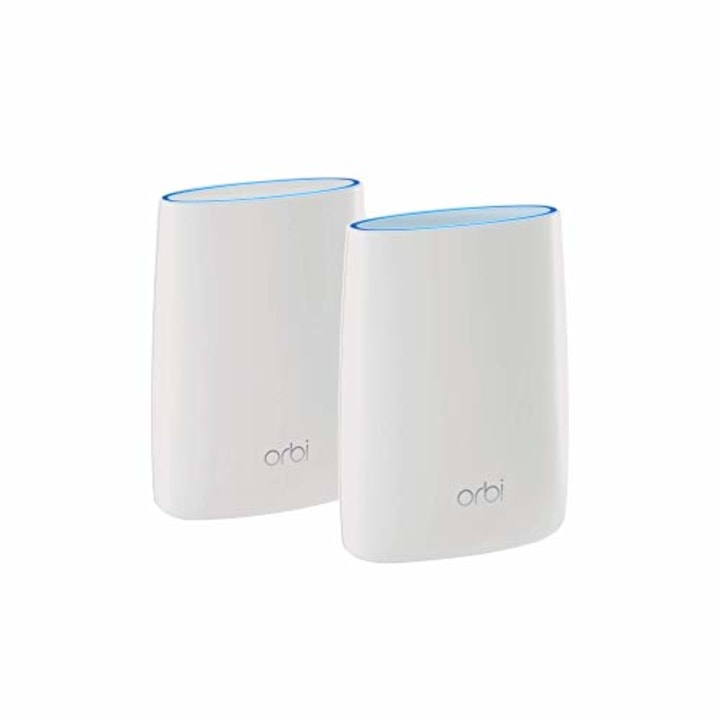What is a mesh Wi-Fi system?
Ever wonder how schools and businesses are able to cover such a large area with one single Wi-Fi network? They use something called mesh networking: the ability to create one network with multiple devices scattered around a space, intelligently communicating with each other. While this technology has been around for a long time, it hasn’t always been easy for just anyone to set up at home.
But that’s all changed in the past few years. A number of consumer-oriented mesh Wi-Fi kits have hit the market in recent years, and they’re a bit different than the old “Wi-Fi extenders” we mentioned above.
Unlike extenders, mesh Wi-Fi systems contain multiple units, all of which are aware of each other’s existence. “New mesh systems, such as Eero, work in a synchronized fashion to provide an improved signal throughout your house, using a single network,” Dionicio advises.
Should you get a mesh Wi-Fi system?
Amazon’s base-level Eero mesh Wi-Fi system, for example, contains three small units you place around your house. You can connect them to each other using Ethernet (if you have Ethernet wiring in your home), or they can repeat the signal to each other wirelessly.
Since each node in the system is designed to work with the others, mesh Wi-Fi networks are easier to set up than extenders. You have just one app that manages all your settings, and each node is smarter about managing what data goes where.
But it has the same speed challenge as wireless extenders: If you use a basic dual-band mesh system without Ethernet, you’ll lose speed as the devices sling data to one another. That’s why I wholeheartedly recommend using a mesh system with Ethernet, if at all possible — many electricians can add Ethernet lines to additional rooms if you don’t have them there.
Best mesh Wi-Fi systems
If Ethernet isn’t an option, I recommend a tri-band mesh system, like the Eero Pro or Netgear Orbi, which dedicates an entire wireless signal to that backhaul.
1. Amazon eero Mesh Wi-Fi System
Eero was one of the pioneers in the consumer mesh Wi-Fi space, and since Amazon acquired it, they’ve released a new base-level system. It’s not the fastest mesh system around, but it comes at a great price compared to the competition, and it’s extremely easy to set up. (If you can wire each unit together with Ethernet in your walls, all the better.)
2. Google Nest Wi-Fi AC2200 Mesh System Router and Point
For a bit more money, Google’s Nest system is a decent alternative to Eero. Each unit contains a microphone for Google Assistant, so you’re basically getting a Google Home Mini built-in to each node. It’s also a bit faster than the base Eero model, so you’re getting a bit more performance for the price.
3. Amazon eero Pro Mesh Wi-Fi System
Amazon’s Eero Pro system is more expensive than the base Eero system and Google’s models. Why? It’s tri-band, which means it has an entire antenna dedicated to sending data between each unit. That means you get significantly faster speeds than you would with less expensive systems, which is important if you don’t have Ethernet in your home to wire each node together. Plus, it has the same easy setup as the rest of the Eero line, which is great for non-technophiles.
4. Netgear Orbi Tri-Band Mesh Wi-Fi System
Netgear’s Orbi system is another popular (and powerful) option. Like the Eero Pro, it’s a tri-band system so you’re getting the best speeds possible when set up wirelessly. Orbi also gives you access to the Disney Circle parental control system, which is great if you have kids. There’s even an Orbi unit with Alexa built-in and a new Orbi system with Wi-Fi 6 — though the latter is a bit too expensive for me to wholeheartedly recommend, it’s there if you want to futureproof your Wi-Fi as much as possible.
Typically, you’d replace your current router with a mesh system. But if you have a router you really like (or you’re stuck using the modem/router combo that comes from your internet provider), you can connect that device to a mesh system like the above and set it to “bridge mode” for the best of both worlds.
All told, I’d recommend equipping your home with a Wi-Fi mesh system over an extender any day. They’re easier to set up and manage, communicate with each other intelligently, and generally provide a better overall experience. An extender will work if you don’t have as much to spend. But the less you spend on it, the closer you’ll find yourself to getting stuck with a clunky system that’s almost as frustrating as no Wi-Fi at all.
More guides and shopping recommendations
Catch up on the latest from NBC Shopping guides and recommendations.















